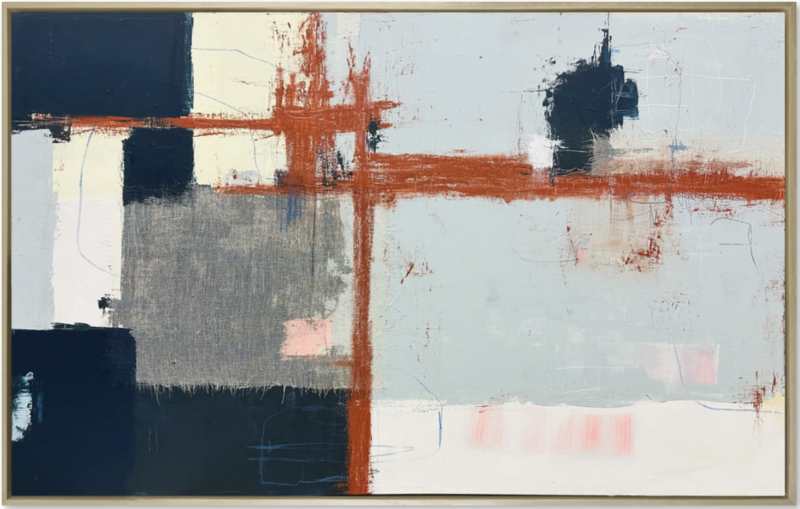 Artist Paig Ring with her work. Photo courtesy of the artist.
Artist Paig Ring with her work. Photo courtesy of the artist.
“I paint intuitively to escape the rigid structure of life’s responsibilities.”
Artwork Archvie’s Featured Artist Paige Ring is drawn to organic shapes, and how the medium moves and interacts on the canvas. “I love the intuitive nature of the abstract, and how it contrasts with the rigid structure of life’s responsibilities,” the artist explains in her artist statement.
She often uses a limited palette to evoke powerful emotions and narratives. “Color tells a story all on its own,” Paige shares, “and the technique of how the color is applied—smooth and soft versus bold and loose—gives that story life."
Paige’s work is a blend of acrylic, ink, resin, pastel, and collage, all employed to create depth and texture. Brushes are often secondary tools in her practice; instead, she favors palette knives, squeegees, and other scraping tools.
Paige often tells herself stories as she paints, yet she cherishes the abstract nature of her work that allows viewers to bring their interpretations, much like a Rorschach inkblot. She finds it fascinating to hear how others connect abstract shapes and lines to concrete images in their minds, offering a glimpse into their perspectives and experiences.
In every piece, Paige Ring invites viewers to tap into their own feelings, allowing her art to serve as a bridge between her inner world and theirs.
Artwork Archive had the chance to chat with Paige Ring about her creative process, what she wishes she had known before becoming a professional artist, and how Artwork Archive helps her manage her art career!
You can see more of her work on Discovery and learn more about her art practice below:
 Paige Ring, Resist The Urge To Fluff The Pillows, 30 x 48 x 1.5 in, Acrylic on canvas.
Paige Ring, Resist The Urge To Fluff The Pillows, 30 x 48 x 1.5 in, Acrylic on canvas.
Can you walk us through your creative process?
I always work on several pieces at once; it keeps me loose and helps me stay in an exploratory, playful state, which is exactly where I want to be for as long as possible.
I don’t plan much, apart from selecting materials and maybe a few colors I want to work with. I start by laying down color and marks and then just let myself respond to them. When I start to slow down with one piece, I move to a new painting.
My goal at this stage is to push the materials and avoid getting attached to anything too quickly. If I start to get too attached to a section or mark, I switch to a new painting, which is why having lots of pieces in progress works well for my practice.
This is easily my favorite part of the process—it’s a lot of fun.
I stay in that rhythm for several days or weeks with a group of paintings. I really love the history that layering creates in a painting, so I’m never worried about what gets covered up.
After a few studio sessions, some of the paintings naturally reach a stage where I like what’s happening, and from there, I become more analytical—balancing the composition, refining the color, and adding subtle details.
Then, of course, comes the finishing stage (i.e., varnishing, framing, photographing, packaging, etc.)."
What stories or themes do you find yourself exploring most frequently in your abstract works?
A painting is a bit like the human experience.
Each event in our lives leaves a mark, creates a break, fray, or connection, and ultimately, those marks make us who we are.
I want my paintings to feel that way. Each layer or mark creates a history and contributes to the balance of perfect imperfection.
 Paige Ring, Just Wait And See, 34 x 60 x 1.5 in, Acrylic on canvas.
Paige Ring, Just Wait And See, 34 x 60 x 1.5 in, Acrylic on canvas.
How does the use of a limited color palette influence the stories and emotions you aim to convey in your paintings?
I want certain colors to be the hero in the work, and I find that using a limited palette helps organize that color hierarchy. I love mixing colors with a limited palette because you can achieve really beautiful harmony throughout the entire piece.
That said, I also spend a lot of time experimenting with odd color pairings.
I really love an unexpected color in a palette; I think it gives the work contrast and a quirky personality.
What impact do you hope to have on those who view your artwork?
The truly beautiful thing about abstraction is the opportunity it gives the viewer to connect what they see to their own experience, so I try not to direct that process too much.
That said, I hope my work feels optimistic to viewers—I think we could all use more of that in our daily lives.
 Paige Ring, Well, Since You Asked, 12 x 12 x 1.5 in, Acrylic on wood.
Paige Ring, Well, Since You Asked, 12 x 12 x 1.5 in, Acrylic on wood.
In hindsight, what’s something you wish you knew before becoming a professional artist?
Looking back, I wish I had known that the pieces I would love the most (and that my collectors consistently gravitate toward) would almost always be the ones that come from pure play and experimentation in the studio.
I’m a bit of an overthinker and planner outside my studio, so much of my practice is about tapping into play, experimenting, and finding ways to stay in that state.
Artwork Archive Tip:
By tracking your artwork, sales, and contacts on Artwork Archive you can easily view who your biggest purchasers are and what artwork is gravitated to the most.
Do you have any rituals or routines to get you in the creative headspace?
Music—there’s always music when I’m working. No specific genre; I bounce through different time periods.
A good playlist is like magic: it not only helps me get into a flow but also helps me move past any frustration or confusion with a piece.
Switch the song, switch the mindset.
Being able to shut off reality for a few hours and quiet everyday life is really important to my practice, and music helps unlock that for me.
Was there a specific instance or time you realized you needed something like Artwork Archive to inventory your artwork and manage your art career?
I realized I needed a proper inventory system about halfway through my first decent year of sales.
I was producing more work and shipping it all over the world, and I found that the systems I set up through spreadsheets wouldn’t provide the long-term organization I wanted.
When I get emails from galleries or collectors, I like to answer them quickly, and having the information for my work in a central location makes that so much easier.
Whether it's pulling up a size or price, tracking which gallery a certain piece is in for a collector, or creating a digitally payable invoice from my phone in a few clicks, Artwork Archive helps me keep my business running smoothly without investing a ton of time.
 Paige Ring, Later Days, 20 x 16 x 1.5 in, Mixed Media on canvas.
Paige Ring, Later Days, 20 x 16 x 1.5 in, Mixed Media on canvas.
How do you use Artwork Archive on a daily basis?
When I finish a piece or a series of works, each piece is photographed and logged in Artwork Archive with the size, medium, location, price, and framing information.
When a work goes to an exhibition, gallery, or is sold, that information is updated for each piece so I always know where it is physically located.
Collectors are logged in my contact section, along with notes on how they found me or any details from our conversations about their likes or dislikes. I handle all my invoicing for the artwork I sell directly and log all my gallery commissions through the platform. The integration with Paypal and credit card payments means I can easily collect payments as well.
As artists, we’re often looked at as flaky or not business-savvy. Having the ability to quickly generate a professional invoice for a collector with just a few clicks, payable through a secure payment system, gives collectors confidence.
Artwork Archive makes me feel in control of all aspects of my business.
I use the Private Rooms feature often as well, either to show a gallery a selection of new work or to present a prospective collector with a group of pieces in the sizes or color families they might want to purchase.
I also use the reporting feature for QR codes and labels, as well as to create Certificates of Authenticity for each piece. It’s truly where I manage everything for my art business.
What advice would you give an artist who’s just starting out in their professional career?
Make a lot of work and don’t worry about selling it—just explore and share what you’re doing.
Don’t rush to find a style, settle on a strict process, or finish work quickly. Even when you do figure out what works for you, shake things up once in a while and learn something new.
Do something you aren’t good at so you can return to that beginner's mindset.
When you do finish a piece, though, carefully document it (photos, video, inventory notes, etc.) because once it’s sold, you rarely get that opportunity back.
A little bit of organization upfront will set your business up for success. That way, you can minimize admin work, and maximize studio time.
Get started building your archive today by exploring Artwork Archive on our free 14 day trial.
Create online portfolios, catalog your inventory, generate professional reports and more!





1b64.png)

